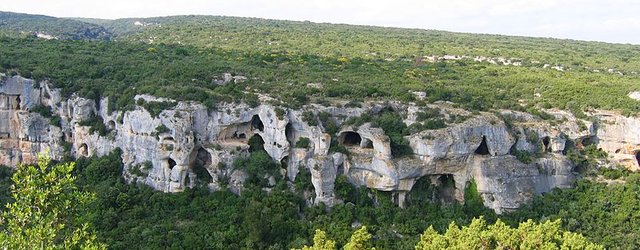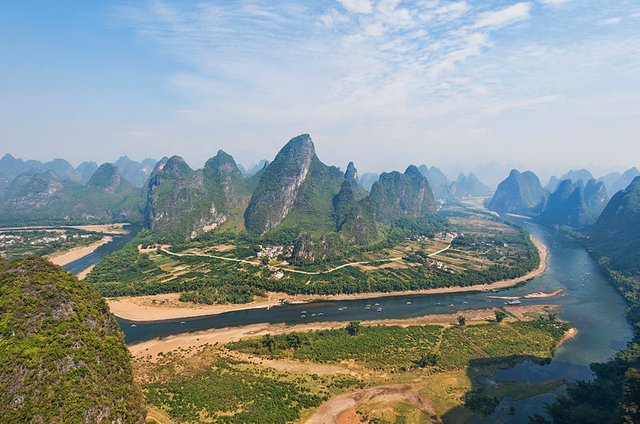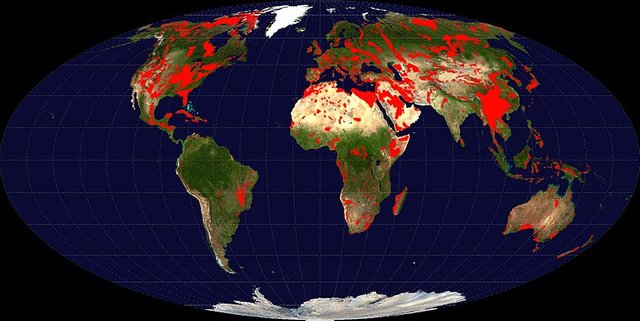Life's Role in Geology: Life's Favorite Rock
75% of the Earth's land surface is covered by sedimentary rocks. Sedimentary rocks are the result of loose sediment being deposited and cemented together- commonly in bodies of water. 10% of all sedimentary rocks are limestone, which is a carbonate rock that is for the most part directly the product of biological activity. Limestone dominated landscapes are known as karsts.

A karst landscape in France. [Image source]
Karsts have a number of distinctive features thanks to their limestone composition. Limestone is somewhat soluble, causing it to erode quickly in comparison to other rocks. Acidic water exacerbates this erosion considerably. This results in truly strange looking landscapes- some of the more exotic regions of Southeast Asia, for instance, have considerable karsts. Most of the world's caves form in karst regions. Limestone also often results in extremely fertile soil.

Karst landscape in China. [Image source]
Limestone has these unusual properties due to its origins- the vast majority is made of the remains of shelled marine organisms, including corals and various shelled marine animals. They form huge limestone platforms- as the corals die and erode, they build up in huge mounds, which cement into stone. When sea levels rise, the corals grow upwards to chase the light, and the huge limestone platforms grow upwards below them. While not all limestone is biogenic (biologically originated) in nature, the vast majority of it is. 7.5% of the world's land surface doesn't sound like a lot, but it translates into a staggering amount of limestone. It's a sign of how important life has been in Earth's history that this much of its surface is essentially entirely a waste product of life.

A map of the karst terrain around the world. [Image source]
Limestone is by far the single best stone for fossil hunting, not least because considerable amounts of the karst around the world are entirely made of fossils. Limestone can only form up to a certain depth in the ocean- below that depth, the added pressure causes it to dissolve even faster.
Limestone formation varies widely throughout the Earth's history. Up until recently, we were amidst a relatively heavy period of limestone formation. Now, however, limestone formation rates are dropping precipitously. Why? Well, to put it simply, us. As we add more carbon dioxide to the atmosphere, it's damaging corals and other limestone forming organisms in two ways. First, global warming related temperature increases in the ocean are quite damaging to corals- they result in deadly coral bleaching events which have wiped out considerable amounts of the world's coral. Second, as the atmospheric CO2 percent increases, raindrops pick up more of it on their way down and react with it chemically, forming carbonic acid. All raindrops are slightly acidic, but their acidity levels have increased significantly since the industrial revolution began. This is raising the acidity levels of the oceans significantly, which in turn makes it much more difficult for marine organisms to form carbonate shells.
The extent of the harm we're doing to our planet isn't just a matter of things we're adding to our environment- it also includes ways in which we're profoundly altering the normal processes of our planet.
This is Part 3 of a series describing life's role in geological processes. Part 1, Part 2.
**********************************************************************
Bibliography:
https://en.wikipedia.org/wiki/Limestone#Degradation_by_organisms
https://en.wikipedia.org/wiki/Karst
https://en.wikipedia.org/wiki/Sedimentary_rock#Sedimentary_basins
My geology classes
If you like the karstic landscape, you have to visit the Torcal de Antequera in Malaga, Spain.
Yesterday I go and is a amazing places, If you want to see some photo, go here El torcal
Cool, I always imagined the land was just way higher up, and then it all eroded away, leaving the much harder mounds of rock standing there to create that Chinese landscape. Nice to correct something in my brain!
Nope! Caves formed, grew bigger and bigger, and started collapsing. Those mounds of rock are the former pillar that supported the caves!
Another great writeup. I've always loved karst landscapes. I never knew they were called karst or how they were formed, but could tell it was unique. You shared some amazing examples with the images, and I never knew it all came down to remnants of life, limestone, then the obvious erosion.
As a long time follower of yours it's great to see your posts consistently getting a nice payout these days. Congrats.
Thanks bud, I appreciate it! And yeah, karst landscapes are definitely often some of the absolute coolest.
img credz: pixabay.com
Nice, you got a 77.0% @cryptomancer upgoat, thanks to @mountainwashere
Want a boost? Minnowbooster's got your back!
Come to Nigeria and ask about zuma rock
Nice Post
Interesting! Thank you for this explanation.
great panorama nice place
Congratulations, your post received one of the top 10 most powerful upvotes in the last 12 hours. You received an upvote from @glitterfart valued at 42.41 SBD, based on the pending payout at the time the data was extracted.
If you do not wish to receive these messages in future, reply with the word "stop".